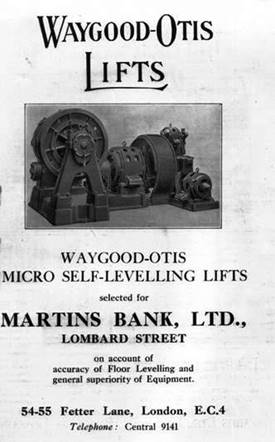|
|
<,

|
|
|
||||||
|
68 Lombard Street in the late
1800s… |
… and again around 1930 just
before the rebuild |
||||||
|
Images © Barclays “Sally forth into the streets”!
Sallying forth into the streets, amid the
dancing lights and shadows of this populous financial quarter, one cannot
fail to experience at the sight of the new {London} headquarters of Martins
Bank that affinity of mental excitement which quiet observation can afford :
to be enamoured, not only by the sympathetic manner in which Sir Herbert
Baker, a.r.a., has preserved
the traditions of the famous Grasshopper, but by meditating upon the history
of what may well be the oldest banking house in the City of London.
|
|||||||
|
|
|
|
|
||||
|
Main Entrance |
Entrance Hall |
War Memorial |
Manager’s Room |
||||
|
Tradition tells that Sir Thomas Gresham, a
mercer, who founded the Royal Exchange on the north side of Cornhill, carried
on a banking business on the site as early as 1563, and from him is derived
the sign of the Grasshopper. Sir Richard Martin, who was Lord Mayor of
London in 1588 and Master of the Mint from 1572 until his death in 1617, had,
without doubt, frequent transactions with Gresham; and thus began the
association of the Martin family with the Grasshopper which has continued to
the present day. Owing to the destruction of title deeds in the Great Fire of
London and the loss of the remaining early records of the Bank, in 1825, in
the fire in the Royal Exchange, it is difficult to trace the occupation of
the Grasshopper during the first half of the seventeenth century.
Ground Floor Plan of the new building
It is. however, known that
subsequent occupants were Edward Backwell, a prominent goldsmith, from 1662
to 1672: and Charles Buncombe and Richard Kent in 1677. about which time the
goldsmiths were beginning to do a regular banking business as we know it. In
1686. Richard Smyth became a partner: so, about 1699, did Andrew Stone. About
this time, also, Thomas Martin was engaged as clerk and later became a
partner. The present chairman of the London board is a representative of the
sixth generation of the family whose name is preserved in the title. Memories of
these old associations are incorporated in the new building.
|
|||||||
|
|
Third and Fourth Floor Plans |
||||||
|
On the main front are carved
the head of a Lombard, or Italian merchant, typifying the chief financial
rivalry with the Jews in the fourteenth century, and the coats of arms of the
families of Gresham and Martin.
Externally the building is of 2-in. Daneshill
bricks with Portland stone dressings and a granite plinth. The lower windows
are bronze; the upper, double sashed, are of teak. In fancy the ghosts of buried centuries seem to glide to
and fro around the site: of Pepys complaining of the transactions of the
"Goldsmiths shops" of speculators in the South Sea bubble, and of Thomas Garraway, who is said to have
established here the first teahouse in London.
The finished building is seen here
(ABOVE LEFT) in a publicity photograph which is used extensively during the
four centuries of banking celebrations that take place in 1963. A memorial to those members of staff killed in the
War Service of their Country is erected in the Banking Hall (BELOW RIGHT) The
Bank’s principal London Office can now accommodate with more ease, the many
departments and offices that were crammed into the old building. The
following advertisements which relate to the rebuilding of 68 Lombard Street,
appear alongside the article in The Architects’ Journal in 1931: |
|||||||
|
|
|||||||
|
|
|
Image: Martins Bank Archive Collections |
|||||
|
Article
text, images and advertisements © The Architects’ Journal 1931
|
|||||||












